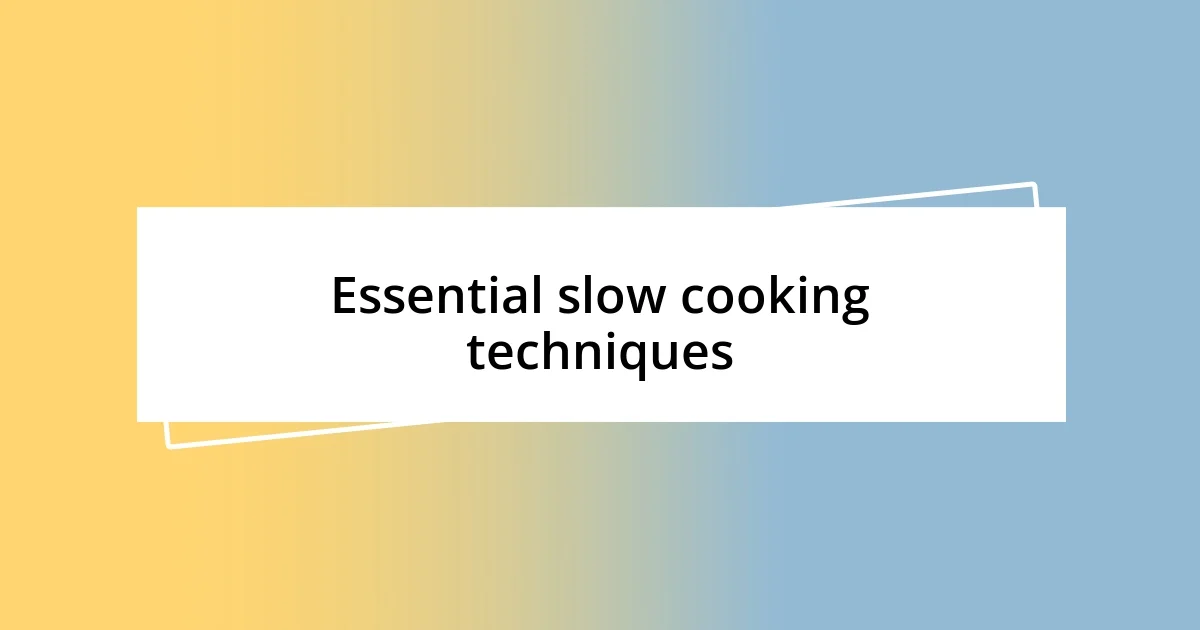Key takeaways:
- Slow cooking enhances flavor and nutrition by allowing ingredients to mingle over long cooking times while retaining their nutrients.
- Choosing the right slow cooker size, shape, and features is crucial for successful meals; proper ingredient layering and moisture control improve cooking results.
- Experimenting with flavors, such as searing ingredients first and using fresh herbs or umami-rich additions, elevates slow-cooked dishes to new levels.

Understanding slow cooking benefits
When I first dived into slow cooking, I was amazed at how it transformed my relationship with food. It’s not just about convenience; it’s about flavor, too. The long cooking times allow spices and ingredients to mingle and deepen, creating rich, complex flavors that are hard to replicate in traditional cooking methods.
One evening, after a long day, I came home to the comforting aroma of a stew that had been simmering all day. It wrapped around me like a warm embrace and instantly made my house feel like home. Doesn’t that sound inviting? Not only does slow cooking provide a delicious meal, but it also fosters a little extra time in the kitchen for reflection. It gives you the space to try new recipes or savor the quiet moments while dinner quietly works its magic.
Let’s not overlook the nutritional benefits either. Cooking at lower temperatures allows ingredients to retain their nutrients better than some other methods. Have you ever noticed how some meals can leave you feeling heavy? With slow cooking, it’s easier to create healthier dishes that still satisfy, like a veggie-packed chili that fills you up without weighing you down. I’ve seen a positive shift in my energy levels since embracing this cooking style, and I can’t help but wonder—could slow cooking give you that same boost?

Choosing the right slow cooker
Choosing the right slow cooker is essential for getting the most out of this cooking style. When I first began my slow cooking journey, I overwhelmed myself with options. I learned that understanding your cooking needs and kitchen space is crucial. Think about how many people you typically cook for—this will guide you toward the right size.
Here’s a quick checklist to keep in mind while choosing a slow cooker:
- Size: A 4-6 quart model is usually perfect for families, while smaller 2-3 quart versions suit singles or couples.
- Shape: Oval slow cookers are great for roasts, while round ones are perfect for soups and stews.
- Settings: Look for models with adjustable heat settings; having high, low, and warm options provides more flexibility based on your schedule.
- Insert Material: Consider whether you want a removable stoneware insert for easy cleaning or a more reliable stainless steel option.
- Smart Features: Some models have timers or even smart settings that can connect to your smartphone, adding convenience to your cooking routine.
Selecting the right slow cooker made all the difference for me. I remember feeling lost when mine started to bubble over, but then I realized I had chosen an unsuitable size for my recipes. Once I picked a larger model with great features, the cooking process became so much smoother. By taking the time to choose wisely, I found joy in the diversity and consistency of my slow-cooked meals.

Essential slow cooking techniques
When it comes to slow cooking, mastering a few essential techniques can elevate your meals. One of my favorites is the “searing first” technique. Searing proteins and vegetables in a hot pan before adding them to the slow cooker enhances the flavors significantly. I remember cooking a beef stew once, and the rich aroma of the seared meat blended beautifully with the vegetables. It made a remarkable difference in taste that I still rave about today.
Another key technique is layering your ingredients appropriately. I’ve learned the hard way that placing root vegetables at the bottom of the slow cooker, where they’ll absorb the heat better, ensures consistent cooking. Some might think that it’s just a matter of throwing everything in, but trust me, the order matters! I recall experimenting with a chicken curry, and when I layered it correctly, the chicken came out tender and the veggies vibrant, making for a comforting dish that I couldn’t wait to share with my family.
Lastly, adjusting the moisture content is crucial. You don’t need to drown your ingredients in liquid; often, the moisture from meats and vegetables is ample. I once made the mistake of overdoing it, resulting in a soupy mess that just didn’t satisfy. Now, I carefully gauge how much liquid to add, ensuring the dish stays hearty. This small tweak not only improves the texture but also brings out the flavors even more.
| Technique | Description |
|---|---|
| Searing First | Brown your ingredients to enhance flavors before slow cooking. |
| Layering Ingredients | Place denser veggies at the bottom for even cooking. |
| Adjusting Moisture | Use just enough liquid to keep dishes hearty without excess soupiness. |

Meal prep for slow cooking
Meal prep is a game-changer when it comes to slow cooking. I remember the first time I went about prepping for a week’s worth of meals—it felt daunting at first, but now it’s second nature. Chopping vegetables or marinating meats ahead of time not only saves me a significant amount of effort during the week but also boosts my excitement about upcoming dinners.
To streamline my meal prep, I often dedicate a couple of hours on weekends to get ingredients ready. I store everything in labeled containers in the fridge, which makes grabbing what I need that much easier. Last Sunday, when I pulled out my prepped garlic-roasted veggies for my stew, the smell wafting through the kitchen brought a smile to my face—it felt like a warm hug from my future self. Who doesn’t enjoy that kind of anticipation?
I’ve also learned that having a solid plan enhances my creativity in the kitchen. Instead of just sticking to familiar recipes, I love experimenting with flavor combinations based on what I prepped. I might’ve set out to make a classic chili, but once I tasted the spiced beans I’d marinated, inspiration struck! I added some tropical fruits on a whim, and the result was a sweet and savory surprise that absolutely delighted my family. Meal prep has truly transformed my slow cooking experience into a delightful adventure.

Flavoring your slow cooked meals
Flavoring your slow cooked meals can truly transform your dining experience. I still remember the first time I added a splash of balsamic vinegar to my slow-cooked vegetables. The tangy sweetness beautifully balanced the earthy flavors, and each bite was a burst of unexpected delight. Have you ever found that one ingredient that turns an ordinary meal into something extraordinary? It’s moments like that which make cooking so rewarding for me.
When it comes to spices, I recommend experimenting with fresh herbs. There’s something magical about tossing in a handful of cilantro or basil right before serving. It’s incredible how the freshness brightens the dish, elevating everything from a hearty stew to a simple braise. I was skeptical at first, but after making a lamb dish that called for mint, I was hooked! The aroma was intoxicating and truly made a difference. The contrast of hot and cold flavors opened my eyes to the potential of layering flavors in slow cooking.
I can’t emphasize enough the power of umami in enriching your meals. Adding ingredients like miso paste or sun-dried tomatoes can create that depth I never knew I was missing. One evening, I tried incorporating a bit of miso into my slow-cooked mushroom risotto. The result? A savory richness that enveloped every grain of rice. It was one of those “wow” moments that reinforced my love for exploring flavors. Isn’t it amazing how a simple twist can lead to such delicious discoveries?

Easy slow cooker recipes
I absolutely love easy slow cooker recipes, and over the years, I’ve collected a few gems that I turn to time and again. One of my favorites is my hearty beef stew. I simply brown some meat, toss in a variety of vegetables like carrots and potatoes, and let the slow cooker work its magic while I catch up on a show. On particularly hectic days, knowing that a warm, comforting meal is waiting for me at the end of the day is a pure joy. Have you experienced that blissful feeling of walking into your home and being greeted by familiar, satisfying aromas?
Another easy recipe I swear by is a creamy chicken taco dish. I place chicken breasts in the slow cooker with taco seasoning and a jar of salsa, letting it simmer away all day. When it’s time to eat, I shred the chicken with two forks, and it’s ready to be piled onto tortillas with all my favorite toppings. I remember the first time I served this dish; my family couldn’t believe how flavorful and tender the chicken was. It’s the kind of meal that sparks laughter and conversation around the dinner table, don’t you think?
Lastly, let’s not overlook the delight of slow-cooked oatmeal. On chilly mornings, there’s something so comforting about waking up to a bowl of warm, creamy oats infused with cinnamon and perhaps a splash of maple syrup. I often prepare it overnight, so all I have to do is scoop it into bowls in the morning. One memorable winter day, I added some almond butter and banana slices, and it felt like a cozy hug in a bowl. Isn’t it wonderful how easy recipes can transform a simple moment into a cherished experience?

Tips for successful slow cooking
One of the key tips for successful slow cooking that I’ve learned is to layer your ingredients thoughtfully. When I first started, I would often just toss everything into the pot, but I quickly realized that arranging vegetables at the bottom and proteins on top allows for even cooking. This not only ensures that the tougher ingredients, like root vegetables, soften nicely, but it also prevents more delicate items from becoming mushy. Have you ever experienced that disappointment of overcooked veggies? I definitely have, and now I take that extra moment to perfect my layering.
Another aspect I find crucial is to seal in flavors with a good browning technique. There’s something undeniably wonderful about the savory crust that forms on meat when you sear it before slow cooking. I remember the first time I browned a roast; the entire house filled with an aroma that promised something amazing. It really does create a depth of flavor that simply can’t be achieved by throwing everything in raw. Have you ever noticed how just one step can elevate a dish from average to exceptional? It’s like adding a secret ingredient that makes everything better!
Lastly, don’t shy away from liquid. I used to worry about drowning my food, thinking it would turn to mush. However, I’ve learned that the right amount of liquid is essential for creating that tender, melt-in-your-mouth texture. Once, I went heavy-handed with broth in a beef stew, and the result was sensational – a rich, hearty sauce that clung to each bite of meat and veggies. Have you ever had a meal that clings to your memories like that? Trust me, achieving that kind of depth is all in the balance of liquid!














